Why using sunscreen every day is essential
Applying sunscreen every day is crucial for shielding your skin from harmful UV rays, preventing premature aging, dark spots, and other sun-related damage.
Regardless of the season, our skin is constantly exposed to ultraviolet rays, which can accelerate the appearance of wrinkles and increase the risk of skin cancer over time.
Many believe facial sunscreen is necessary only during the summer, but dermatologists recommend year-round sun protection, even on cloudy days.
How to combine sunscreen with Makeup for long-lasting protection
One of the most common concerns is whether SPF affects makeup durability. Here are some frequently asked questions :
- Does sunscreen reduce the longevity of makeup?
- What is the best facial sunscreen for daily use?
- How can you reapply SPF without ruining your makeup?
In this guide, you'll discover the best sunscreens for makeup and how to apply them correctly to ensure effective protection while maintaining a flawless look.
How to properly apply sunscreen under Makeup
To achieve a perfect makeup look while ensuring effective sun protection, it's essential to choose a lightweight facial sunscreen that absorbs quickly and leaves no residue. A heavy SPF can affect makeup longevity, causing shine and uneven texture on the skin.
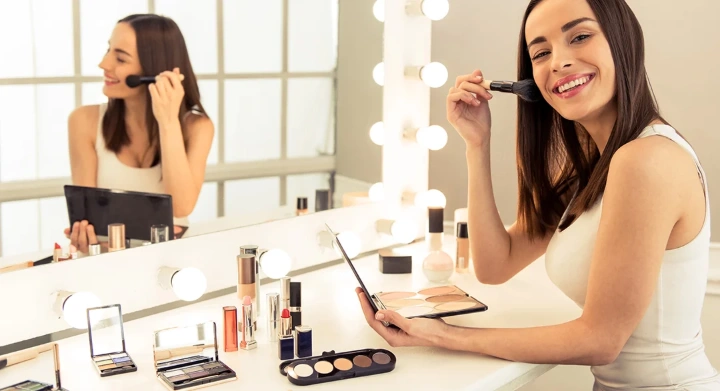
Ideal features of sunscreen for Makeup
- Transparent SPF that blends seamlessly into the skin, avoiding a white cast.
- Mattifying formula, perfect for oily or combination skin.
- Fluid texture, making application easy without altering foundation performance.
💡 Tip: opt for oil-free sunscreens, especially if you wear makeup daily, to prevent a heavy or greasy feel on the skin.
Every person’s skin is unique, so there is no one-size-fits-all solution. However, following some key guidelines can help you select the best facial sunscreen for your needs.
Beyond skin type (oily, dry, combination, sensitive), it’s also important to consider its current condition:
- Damaged skin – recovering from chemical peels, laser treatments or other aesthetic procedures.
- Dehydrated skin – caused by harsh cleansers or the use of medicated skincare products.
- Photo-damaged skin – showing signs of sun-induced aging (photoaging), such as dark spots, dilated capillaries, and fine lines.
💡 Tip: in all these cases, before applying sunscreen, use a hydrating serum or repairing cream to address the primary skin concern .
Correct order of SPF and Makeup application
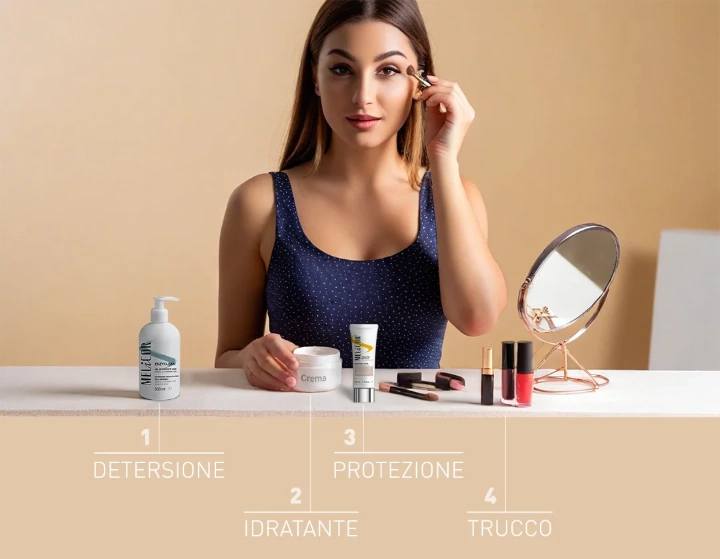
To ensure effective sun protection without compromising makeup longevity, follow this sequence:
- Cleanse your skin with a gentle face wash and pat dry.
- Apply a hydrating cream – If your skin is dry, use a moisturizer before sunscreen.
- Apply sunscreen (SPF) – spread an even layer and let it absorb for 10-15 minutes before makeup.
- Use a primer – helps set makeup and minimize imperfections.
- Apply foundation or BB cream with SPF – for extra protection, choose products with built-in UV filters.
- Set your makeup – use a mattifying powder or setting spray to keep your look flawless.
💡 Common mistake to avoid: do not mix sunscreen with foundation, as this can reduce UV protection and alter product consistency.
Common Mistakes When Applying Sunscreen
Applying SPF without cleansing can lead to breakouts and irritation. Residual oil and impurities may interfere with sunscreen absorption, reducing its effectiveness.
💡 Tip: before applying facial sunscreen, cleanse your skin with a gentle, skin-type-appropriate cleanser.
Some people mix sunscreen with moisturizer to simplify their routine, but this method does not ensure even protection. UV filters may distribute unevenly, leaving certain areas exposed to sun damage.
Our tinted SPF 50 sunscreen, which adapts to your skin tone, can also be used as a base for makeup. The presence of hyaluronic acid with ectoine will ensure the skin is hydrated.
💡 Tip: use tinted sunscreen SPF 50, which adapts to your skin tone and doubles as a makeup base. Ingredients like hyaluronic acid and ectoine help keep skin hydrated.
Mixing foundation with sunscreen before application can reduce the effectiveness of the protection. Sunscreens should be applied directly to the skin, without diluting them with other products.
Our tinted SPF 50 sunscreen, which adapts to your skin tone, can also be used as a base for makeup. The presence of hyaluronic acid with ectoine will ensure the skin is hydrated.
💡 Tip: use tinted sunscreen SPF 50, which adapts to your skin tone and doubles as a makeup base. Ingredients like hyaluronic acid and ectoine help keep skin hydrated.
One of the most common mistakes is applying makeup immediately after sunscreen, without waiting for absorption. This can compromise sun protection and cause makeup to pill or break apart.
💡 Golden rule: after applying facial sunscreen, wait at least 10-15 minutes before proceeding with makeup .
Best Sunscreens for Makeup
When choosing a facial sunscreen, it’s essential to find a product that protects the skin without compromising makeup longevity. The best sunscreens for makeup have lightweight textures, absorb quickly, and leave no white residue.
Lightweight and invisible Sunscreens
Sunscreens with a fluid formula are perfect for daily makeup wearers.
Ideal Features:
- Transparent SPF, that doesn’t alter foundation color.
- Oil-free formula, to prevent excess shine.
- Lightweight texture, that blends seamlessly with makeup.
💡 Tip: choose a SPF 50 sunscreen enriched with hyaluronic acid to keep skin hydrated and protected.
We recommend
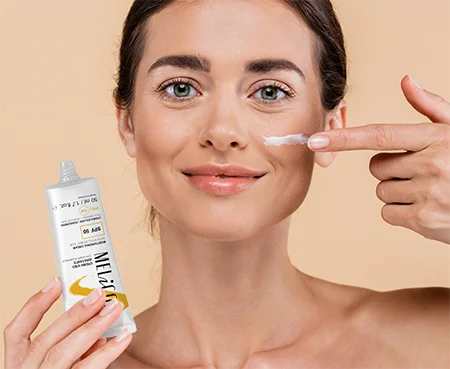
SPF 50 moisturiser face cream for sensitive skin
Apply and forget about skin discomfort with our SPF 50 Hydrating Face Cream with Hyaluronic Acid and Ectoine.
Foundation with SPF: Can They Replace Sunscreen?
Many foundations contain SPF, but can they truly replace sunscreen?
💡 Common mistake: foundation with SPF provides limited protection because it is applied in a thin layer and does not ensure even coverage.
Solution: Apply a SPF 50 sunscreen first, let it absorb for 10-15 minutes, then apply foundation for a flawless and protected makeup look.
We recommend
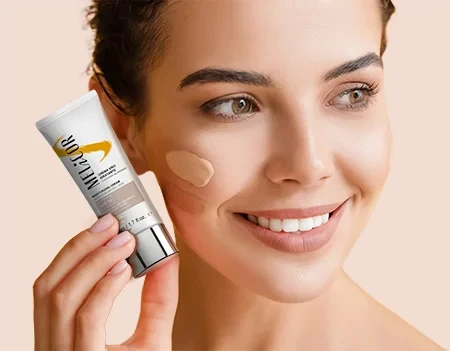
SPF 50 tinted moisturiser
Feel the lightweight texture of this tinted SPF 50 sunscreen face cream that disappears upon application and does not leave a greasy film on the skin. It evens out skin tone and can be used as a base for makeup. Our advanced hydration allows skin to breathe and stay hydrated.
How to reapply Sunscreen during the day
Applying sunscreen in the morning is essential, but it’s not enough to ensure all-day protection. Sweat, oil, and contact with surfaces like phones or tissues can reduce SPF effectiveness, leaving your skin exposed to UV rays.
💡 Golden rule: to maintain optimal sun protection, reapply SPF every 2-3 hours, even if you're wearing makeup .
Using Sunscreen sprays for the face
Sunscreen sprays are the perfect solution for refreshing sun protection without ruining makeup. They are lightweight, transparent, and easy to apply with just a few spritzes.
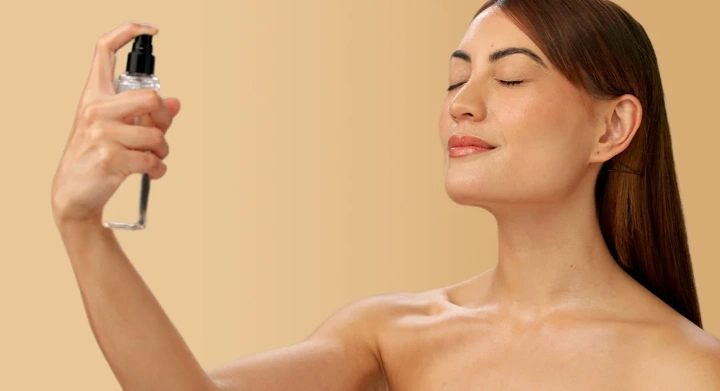
Benefits of SPF sprays:
- Won’t disrupt makeup or leave a greasy finish.
- Quick and easy application without rubbing.
- Provides even UV protection across the face.
💡 Tip: choose a SPF 50 spray sunscreen with hydrating ingredients like hyaluronic acid and ectoine to keep skin fresh and protected .
Does SPF powder really work?
SPF powders are a great alternative for those who want to refresh sun protection without applying a cream.
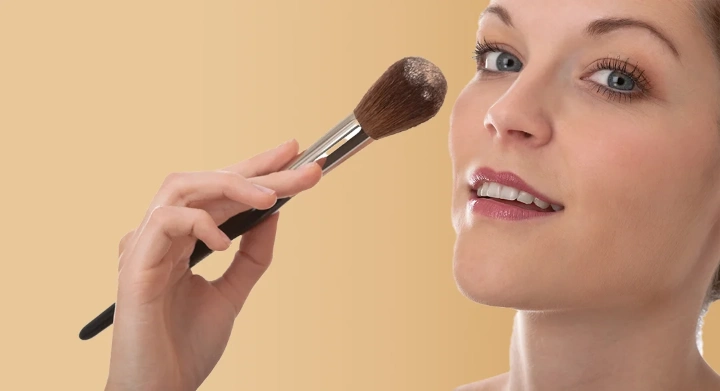
Benefits of SPF powder:
- Mattifies skin and controls oil.
- Provides UV protection without affecting makeup.
- Easy to apply throughout the day.
💡 Common mistake: SPF powder does not replace sunscreen! It helps boost protection, but it does not provide full UV defens.
How to Reapply Sunscreen Over Makeup
If you need extra sun protection, you can apply a fluid sunscreen over your makeup. Use a sponge or fingertips to gently pat the product onto your skin, avoiding makeup smudging.
💡 Tip: choose a lightweight, transparent sunscreen that absorbs quickly without leaving residue.
Conclusion: Sunscreen and Makeup – the perfect combination
Integrating sunscreen into your beauty routine is essential for maintaining healthy skin and preventing UV damage. Applying SPF correctly under makeup ensures effective sun protection without compromising your look.
💡 Essential rules for perfect sun protection:
- Choose a lightweight, transparent sunscreen, that absorbs quickly.
- Apply SPF every morning, even on cloudy days.
- Reapply sunscreen every 2-3 hours, using SPF spray or powder.
- Do not mix sunscreen with foundation, to ensure even UV protection.
By following these tips, you can protect your skin from UV rays while maintaining a flawless makeup look. Daily sun protection is the key to radiant, youthful, and healthy skin.